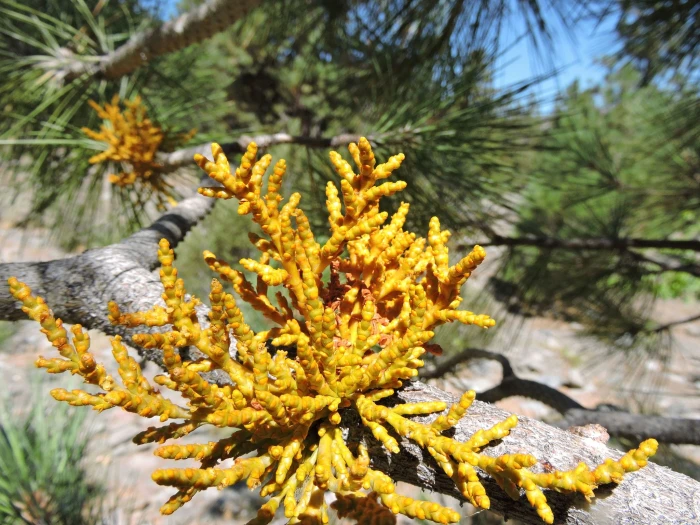Western Dwarf Mistletoe
(Arceuthobium campylopodum)
Western Dwarf Mistletoe (Arceuthobium campylopodum)
/
/

cwwood
CC BY-SA 4.0
Image By:
cwwood
Recorded By:
Copyright:
CC BY-SA 4.0
Copyright Notice:
Photo by: cwwood | License Type: CC BY-SA 4.0 | License URL: http://creativecommons.org/licenses/by-sa/4.0/ | Rights Holder: cwwood | Publisher: iNaturalist | Date Created: 2016-08-01T13:00:36-07:00 |












Estimated Native Range
Climate Requirements for Mentor, Ohio
| This Plant | Your Site | Plant Suitability for Your Location | ||
|---|---|---|---|---|
| • Precipitation | 8" - 90" | 38" | Aquatic | Aquatic |
| • High Temp. | 60°F - 103°F | 83°F | Your summer temperatures are normal for this plant. | Excellent |
| • Low Temp. | 2°F - 43°F | 19°F | Your winter temperatures are normal for this plant | Excellent |
This plant may not grow well at your location - your precipitation is too high.
Summary
Arceuthobium campylopodum, commonly known as western dwarf mistletoe, is a parasitic plant native to coniferous forests in the western United States, particularly within the Sierra Nevada, the Cascade Range, and the Rocky Mountains. It specifically targets various species of pine trees, such as Jeffrey Pine, Ponderosa Pine, and Coulter Pine. The plant’s greenish-yellow shoots emerge from the bark of its host, while the majority of its structure, including the haustoria that extract nutrients, remains hidden beneath the bark. Western dwarf mistletoe is not typically cultivated due to its parasitic nature and potential harm to host trees.
Western dwarf mistletoe is known for its ecological role within its native habitat, where it can influence forest structure and biodiversity. It is not used in traditional cultivation but may be of interest for study in forest ecology and management. In terms of cultivation, it requires a specific host tree and is not suitable for general garden planting. It can be problematic due to its parasitic lifestyle, which can weaken and eventually kill host trees, and it is considered invasive in some regions outside its native range. Before considering it for any purpose outside its native habitat, it is crucial to check local regulations and invasive species lists.CC BY-SA 4.0
Western dwarf mistletoe is known for its ecological role within its native habitat, where it can influence forest structure and biodiversity. It is not used in traditional cultivation but may be of interest for study in forest ecology and management. In terms of cultivation, it requires a specific host tree and is not suitable for general garden planting. It can be problematic due to its parasitic lifestyle, which can weaken and eventually kill host trees, and it is considered invasive in some regions outside its native range. Before considering it for any purpose outside its native habitat, it is crucial to check local regulations and invasive species lists.CC BY-SA 4.0
Plant Description
- Plant Type: Shrub
- Height: 0.2-0.5 feet
- Width: 1-2 feet
- Growth Rate: Moderate
- Flower Color: Green, Yellow
- Flowering Season: Summer, Fall, Winter
- Leaf Retention: Evergreen
Growth Requirements
- Sun: Full Sun
- Water: Medium, High
- Drainage: Fast
Common Uses
Bird Garden, Low Maintenance
Natural Habitat
Native to coniferous forests in the western United States, particularly within the Sierra Nevada, the Cascade Range, and the Rocky Mountains
Other Names
Common Names: Pine Dwarf Mistletoe
Scientific Names: Arceuthobium campylopodum
GBIF Accepted Name: Arceuthobium campylopodum